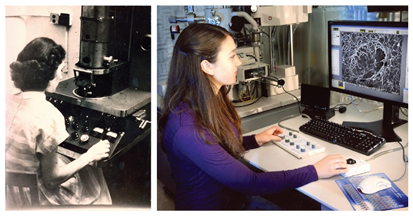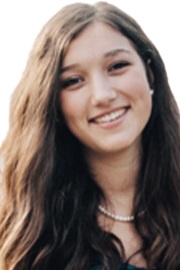
In this interview, AZoM talks to Sophia Antonioli-Schmit, a student researcher at the National Health Institute’s Rocky Mountain Laboratories (RML), about her history with electron microscopy.
So, when did your family connection with microscopy begin?
My grandmother, Patricia Schmit (née Weber) was actually a microscopist in the 1940s, around 1946 specifically. Her background was in chemistry and she worked for Battelle (Battelle Memorial Institute) for about three or four years.
Do you know what she studied at Battelle?
I think it was mostly remnants of war-era materials science and structural research, focusing specifically on steel. Since my background is in biology, I don’t understand the finer details of her work, but the focus was on stress and fracture analysis; they were trying to determine how the material would behave in military applications such as tanks, bombs, etc.

Microscopy across generations: Patricia Schmit (1948) and Sophia Antonioli-Schmit (2019) working on electron microscopy over 70 years apart.
As you can imagine, this was a pretty interesting time in the sciences because men were just returning from the war. So initially, she really had the freedom to take control of her own projects and made some significant advances in the field; she was quite respected in her department. Then, as the men started finishing up their degrees and returning to the work force, traditional gender roles began to reassert themselves everywhere, including the sciences.
So, although she was a significant contributor in prior lab meetings, her role was starting to be diminished; now she was being asked to grab coffee or sharpen pencils. Obviously, this is a pretty devastating turn, considering that she was a published research scientist.
Eventually, her previous responsibilities were assigned to men with less training and experience. Looking for other ways to contribute, she considered changing tracks and going into statistics, but she was also a religious woman. At the time her priest approached her and told her that their school was short on teachers, and she decided it was time to serve the church. She became a teacher for the rest of her career and taught high school chemistry as well as elementary school.
It’s been interesting to compare my own journey in electron microscopy to hers; it’s encouraging to see how far the technology and the position of women in the industry has come.
What made her pursue chemistry initially?
She was actually first turned on to chemistry at St. Francis College, a Catholic college for women. Apparently, she was particularly inspired by this nun, a chemist, who would teach chemistry lab in a full habit, with her lab coat on top of that. And I guess that she was just so passionate about science and chemistry that it really inspired my grandma, and in turn inspired generations after that.
Did you know about this familial background with electron microscopy when you started working with the technique, or was this mostly coincidental?
Well, I was never actually able to meet my grandma, she died before I was born. I think I'd heard whispers of a family connection to microscopy, but most of the stories that I'd heard were from her time as a teacher, and they were great. She was an amazing teacher. But I didn't really know the depth of her involvement in electron microscopy until we started to dig up documents from Battelle; meeting notes, papers, etc.
What are you studying now?
So right now, I'm working with the NIH. Specifically, I've been part of a collaborative project between the core electron microscopy and salmonella units at RML. We’re using correlative light and electron microscopy to observe a region of tissue invaded by salmonella in order to better understand the ultrastructural changes that take place under the influence of the disease. Since we’re trying to use a biologically relevant model, the infectious dose is hard to target. You have to use a correlative approach to really see what you’re doing.
What do you see yourself doing from here on out? Are you going to stick with microscopy?
I'm still finishing up my degree, so I have a little more time to decide, but I really love microscopy. I think it's just incredible. I always say it's just like you're an explorer, looking at these alien landscapes, and according to my dad, my grandma used to say the same exact thing. It’s just so funny that there are these parallels, that we're really captivated by it for the same reasons.
About Sophia Antonioli-Schmit
 Sophia Antonioli-Schmit is a student researcher at the National Health Institute’s Rocky Mountain Laboratories (RML) in Hamilton, Montana. She sat down with us at the Microscopy & Microanalysis 2019 Meeting to discuss her surprising family history with electron microscopy.
Sophia Antonioli-Schmit is a student researcher at the National Health Institute’s Rocky Mountain Laboratories (RML) in Hamilton, Montana. She sat down with us at the Microscopy & Microanalysis 2019 Meeting to discuss her surprising family history with electron microscopy.
Disclaimer: The views expressed here are those of the interviewee and do not necessarily represent the views of AZoM.com Limited (T/A) AZoNetwork, the owner and operator of this website. This disclaimer forms part of the Terms and Conditions of use of this website.